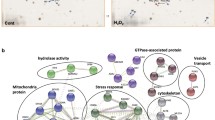Abstract
Protein glutathionylation is a posttranslational process that regulates protein function in response to redox cellular changes. Furthermore, carbon monoxide-induced cellular pathways involve reactive oxygen species (ROS) signaling and mitochondrial protein glutathionylation. Herein, it is described as a technique to assess mitochondrial glutathionylation due to low concentrations of CO exposure. Mitochondria are isolated from cell culture or tissue, followed by an immunoprecipitation assay, which allows the capture of any glutathionylated mitochondrial protein using a specific antibody coupled to a solid matrix that binds to glutathione antigen. The precipitated protein is further identified and quantified by immunoblotting analysis.
Access this chapter
Tax calculation will be finalised at checkout
Purchases are for personal use only
Similar content being viewed by others
References
Gallogly MM, Mieyal JJ (2007) Mechanisms of reversible protein glutathionylation in redox signaling and oxidative stress. Curr Opin Pharmacol 7:381–391
Popov D (2014) Protein S-glutathionylation: from current basics to targeted modifications. Arch Physiol Biochem 120:123–130
Mailloux RJ, Treberg JR (2016) Protein S-glutathionlyation links energy metabolism to redox signaling in mitochondria. Redox Biol 8:110–118. https://doi.org/10.1016/j.redox.2015.12.010
Chen YR, Chen CL, Pfeiffer DR, Zweier JL (2007) Mitochondrial complex II in the post-ischemic heart. J Biol Chem 282:32640
Giangregorio N, Palmieri F, Indiveri C (2013) Glutathione controls the redox state of the mitochondrial carnitine/acylcarnitine carrier Cys residues by glutathionylation. Biochim Biophys Acta Gen Sub 1830:5299–5304
Kang PT, Zhang L, Chen CL, Chen J, Green KB, Chen YR (2012) Protein thiyl radical mediates S-glutathionylation of complex I. Free Radic Biol Med 53:962–973
Queiroga CSF, Almeida AS, Martel C, Brenner C, Alves PM, Vieira HLA (2010) Glutathionylation of adenine nucleotide translocase induced by carbon monoxide prevents mitochondrial membrane permeabilization and apoptosis. J Biol Chem 285:17077–17088. https://doi.org/10.1074/jbc.M109.065052
Sun R, Eriksson S, Wang L (2012) Oxidative stress induced S-glutathionylation and proteolytic degradation of mitochondrial thymidine kinase 2. J Biol Chem 287:24304–24312
Ryter SW, Choi AMK (2016) Targeting heme oxygenase-1 and carbon monoxide for therapeutic modulation of inflammation. Transl Res 167:7–34
Figueiredo-Pereira C, Dias-Pedroso D, Soares NL, Vieira HLA (2020) CO-mediated cytoprotection is dependent on cell metabolism modulation. Redox Biol 32:101470
Almeida AS, Figueiredo-Pereira C, Vieira HLA (2015) Carbon monoxide and mitochondria-modulation of cell metabolism, redox response and cell death. Front Physiol 6:33
Zuckerbraun BS, Chin BY, Bilban M, de Costa d’Avila J et al (2007) Carbon monoxide signals via inhibition of cytochrome c oxidase and generation of mitochondrial reactive oxygen species. FASEB J 21:1099–1106
Suliman HB, Carraway MS, Ali AS, Reynolds CM, Welty-wolf KE, Piantadosi CA (2007) The CO / HO system reverses inhibition of mitochondrial biogenesis and prevents murine doxorubicin cardiomyopathy. J Clin Invest 117:3730–3741
Almeida AS, Soares NL, Vieira M, Gramsbergen JB, Vieira HLA (2016) Carbon monoxide releasing molecule-A1 (CORM-A1) improves neurogenesis: increase of neuronal differentiation yield by preventing cell death. PLoS One 11:e0154781
Scragg JL, Dallas ML, Wilkinson JA, Varadi G, Peers C (2008) Carbon monoxide inhibits L-type Ca2+ channels via redox modulation of key cysteine residues by mitochondrial reactive oxygen species. J Biol Chem 283:24412–24419
Taillé C, El-Benna J, Lanone S, Boczkowski J, Motterlini R (2005) Mitochondrial respiratory chain and NAD(P)H oxidase are targets for the antiproliferative effect of carbon monoxide in human airway smooth muscle. J Biol Chem 280:25350–25360
Costantini P, Chernyak BV, Petronilli V, Bernardi P (1996) Modulation of the mitochondrial permeability transition pore by pyridine nucleotides and dithiol oxidation at two separate sites. J Biol Chem 271:6746–6751
Costantini P, Belzacq A-SS, Vieira HLA, Larochette N et al (2000) Oxidation of a critical thiol residue of the adenine nucleotide translocator enforces Bcl-2-independent permeability transition pore opening and apoptosis. Oncogene 19:307–314. https://doi.org/10.1038/sj.onc.1203299
Vieira HLA, Boya P, Cohen I, Hamel CE et al (2002) Cell permeable BH3-peptides overcome the cytoprotective effect of Bcl-2 and Bcl-X(L). Oncogene 21:1963–1977
Kristian T, Fiskum G (2004) A fluorescence-based technique for screening compounds that protect against damage to brain mitochondria. Brain Res Protoc 13:176–182
Kristián T, Gertsch J, Bates TE, Siesjö BK (2000) Characteristics of the calcium-triggered mitochondrial permeability transition in nonsynaptic brain mitochondria: effect of cyclosporin A and ubiquinone O. J Neurochem 74:1999–2009
Sims NR (1990) Rapid isolation of metabolically active mitochondria from rat brain and subregions using percoll density gradient centrifugation. J Neurochem 55:698–707
Motterlini R, Clark JE, Foresti R, Sarathchandra P, Mann BE, Green CJ (2002) Carbon monoxide-releasing molecules: characterization of biochemical and vascular activities. Circ Res 90:e17–e24
Acknowledgments
This work was supported by the Portuguese Fundação para a Ciência e Tecnologia (FCT) for the grants FCT-ANR/NEUNMC/0022/2012 and UID/Multi/04462/2013, I&D 2015-2020 iNOVA4Health – Programme in Translacional Medicine; and for ASA’s SFRH/BD/78440/2011 and CFP’s SFRH/BD/106057/2015 fellowships.
Author information
Authors and Affiliations
Corresponding author
Editor information
Editors and Affiliations
Rights and permissions
Copyright information
© 2021 Springer Science+Business Media, LLC, part of Springer Nature
About this protocol
Cite this protocol
Almeida, A.S., Figueiredo-Pereira, C., Vieira, H.L.A. (2021). Assessment of Mitochondrial Protein Glutathionylation as Signaling for CO Pathway. In: Weissig, V., Edeas, M. (eds) Mitochondrial Medicine . Methods in Molecular Biology, vol 2276. Springer, New York, NY. https://doi.org/10.1007/978-1-0716-1266-8_19
Download citation
DOI: https://doi.org/10.1007/978-1-0716-1266-8_19
Published:
Publisher Name: Springer, New York, NY
Print ISBN: 978-1-0716-1265-1
Online ISBN: 978-1-0716-1266-8
eBook Packages: Springer Protocols




